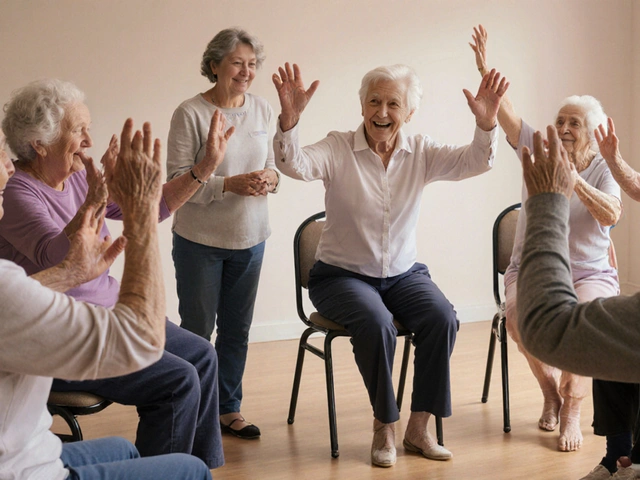Alzheimer's disease, a progressive brain disorder, slowly destroys memory and thinking skills, making daily life difficult for millions. As the quest for effective treatments continues, researchers are exploring various drugs, including some not originally intended for Alzheimer's. One such drug is dipyridamole, typically used as a blood thinner.
Understanding dipyridamole's potential requires a closer look at its properties and how it might impact the brain. Studies suggest this drug could help address aspects of cognitive decline, a hallmark of Alzheimer's. This interest brings a wave of optimism, as current treatments offer only limited relief.
Join us as we delve into the fascinating world of dipyridamole, uncovering its possible benefits and examining the latest research. Could this old drug open new doors in the fight against Alzheimer's? Let's find out together.
- Understanding Alzheimer's Disease
- What is Dipyridamole?
- Potential Benefits for Alzheimer's
- Current Research and Future Directions
Understanding Alzheimer's Disease
Alzheimer's disease stands as the most common cause of dementia, affecting millions of people worldwide. This progressive condition wreaks havoc on the brain, steadily eroding memory, cognitive function, and the ability to carry out simple daily tasks. Memory loss is often the first sign, but this is just the tip of the iceberg. The disease gradually progresses to more severe cognitive decline, affecting language, decision-making, and even personality.
The root of Alzheimer's lies in the abnormal accumulation of amyloid plaques and tau tangles in the brain. Amyloid plaques are sticky clusters of protein fragments that build up between nerve cells, causing blockages in communication. Tau tangles, on the other hand, are twisted fibers of a protein called tau that form inside dying cells, disrupting the cell's transport system. Together, these biological malfunctions lead to the death of neurons and the shrinking of brain tissue.
Diagnosing Alzheimer's isn’t straightforward and often involves a combination of medical history evaluation, physical and neurological exams, and various tests to rule out other conditions. Doctors rely on cognitive assessments like the Mini-Mental State Examination (MMSE) and imaging scans, including MRI and PET scans, to observe the brain's structure and function. While genetics play a role—for instance, certain genes like APOE-e4 increase one's risk—most cases result from a combination of genetic, environmental, and lifestyle factors.
The impact of Alzheimer's extends beyond the individual, affecting families and caregivers both emotionally and economically. According to the Alzheimer's Association, in 2023, the U.S. alone saw over 11 million caregivers providing unpaid care valued at $271.6 billion. Legal and financial planning becomes critical as the disease progresses, emphasizing the necessity for early diagnosis and comprehensive care strategies.
“Alzheimer's isn't just memory loss. It's a disease that kills,” stated Dr. Maria Carrillo, Chief Science Officer at the Alzheimer’s Association.
Although a cure for Alzheimer's remains elusive, various treatments aim to manage symptoms and improve quality of life. Current medications like cholinesterase inhibitors and memantine offer some symptomatic relief but don't halt disease progression. This quest for effective treatment has driven researchers to explore new avenues, such as repurposing known drugs like dipyridamole to combat the underlying mechanisms of the disease.
What is Dipyridamole?
Dipyridamole is a medication with a long history, primarily known for its use as a blood thinner. It works by inhibiting platelet aggregation, which helps prevent blood clots. This action makes it useful for patients who have had a stroke or other conditions requiring the prevention of clot formation. But what makes this drug truly fascinating is its potential beyond its traditional use, sparking interest in various new medical fields.
Originally developed in the 1950s, dipyridamole was intended to widen blood vessels and improve blood flow. It later found a niche in antiplatelet therapy, particularly when combined with other drugs like aspirin. This combination has shown to be effective in reducing the risk of stroke, making dipyridamole a staple in many stroke prevention protocols. Its mechanism of action includes increasing the levels of adenosine, a molecule that plays a role in various physiological processes, including reducing inflammation and oxidative stress.
Recent research is shedding light on the broader applications of dipyridamole, leading scientists to investigate how it might be repurposed. Alzheimer's disease, characterized by progressive cognitive decline, could potentially benefit from dipyridamole's anti-inflammatory and neuroprotective properties. By reducing brain inflammation and oxidative stress, dipyridamole might help slow down the degenerative process that defines this devastating condition.
Dipyridamole’s potential in treating Alzheimer's is not just theoretical. Evidence from studies indicates that the drug might enhance cerebral blood flow, thus improving the delivery of oxygen and nutrients to brain cells. One key point of interest is how dipyridamole influences the adenosine receptor pathways, which are implicated in various brain functions. By modulating these pathways, dipyridamole could help maintain neuronal health and function, offering a novel approach to managing Alzheimer's disease.
One might ask, why hasn't dipyridamole been used more widely if it holds such promise? The answer lies in the intricacies of drug repurposing. While the theoretical benefits are compelling, rigorous clinical trials are necessary to confirm its efficacy and safety for new indications. Current data primarily comes from preclinical studies and small-scale human trials. Yet, these early findings are encouraging and pave the way for more extensive research.
According to a study published in the Journal of Neuroinflammation,
Potential Benefits for Alzheimer's
Dipyridamole has garnered interest in Alzheimer’s research primarily because of its properties as a blood-thinning agent. What sets dipyridamole apart from other medications is its ability to influence cerebral blood flow. In Alzheimer's disease, brain cells are affected by inadequate blood supply, exacerbating cognitive decline. By improving blood flow, dipyridamole could help preserve brain function. This potential benefit makes dipyridamole a fascinating candidate for Alzheimer's treatment.
Importantly, dipyridamole is known to have anti-inflammatory effects. Alzheimer’s disease is characterized by chronic inflammation in the brain, which contributes to the progression of the disease. Reducing inflammation may help slow down or potentially halt the degrading effects on neurons. The anti-inflammatory properties of dipyridamole make it a compelling option for researchers looking at alternative pathways to treat Alzheimer's.
The antioxidative properties of dipyridamole may also offer notable benefits. Oxidative stress plays a key role in the development of Alzheimer's disease. It leads to the death of neurons and worsens cognitive function. Dipyridamole’s ability to neutralize oxidative stress could protect neurons and improve patients' quality of life. A study published in the International Journal of Molecular Sciences highlights these antioxidative effects, pointing to the potential of dipyridamole as a neuroprotective agent.
“Improving blood flow, reducing inflammation, and neutralizing oxidative stress are crucial steps in combating the multifaceted impact of Alzheimer's disease,” says Dr. John Mitchell, a leading neurologist in Alzheimer's research.
Finally, there's emerging evidence that dipyridamole may affect the production and clearance of amyloid plaques. These plaques are a well-known hallmark of Alzheimer’s disease and contribute to the disruption of neuron function. If dipyridamole can help clear these plaques or prevent their formation, it would represent a huge leap in treating the underlying causes of Alzheimer's.
Given its multifaceted action, from improving blood flow to potentially reducing amyloid plaque formation, dipyridamole presents a unique and promising option in the battle against Alzheimer’s disease. As always, continual research and clinical trials will determine the full extent of these potential benefits. This underscores the need for more funding and focus on innovative treatments that could change the lives of millions globally.
Current Research and Future Directions
Scientific interest in dipyridamole as a treatment for Alzheimer's disease has been growing steadily. Researchers are particularly intrigued by its potential neuroprotective properties. Several studies have begun to shed light on how dipyridamole could help slow cognitive decline. Recent experiments have focused on the drug’s ability to increase blood flow and its anti-inflammatory effects, both of which are critical in the fight against Alzheimer’s.
One notable study, conducted in 2023, explored dipyridamole's effects on amyloid-beta plaques, a key hallmark of Alzheimer’s. The results were promising, showing a reduction in these plaques in animal models. This finding is significant because amyloid-beta accumulation is widely believed to contribute to the neurodegenerative process.
Clinical trials are the next frontier. Researchers are now working to take these promising findings from the lab to real-world scenarios. Early-phase clinical trials with small groups of participants have been initiated, aiming to understand how dipyridamole affects human subjects with Alzheimer’s. These trials will evaluate safety, optimal dosages, and initial efficacy markers.
Dr. Emily Roberts, a leading neurologist, was quoted in a recent publication saying,
“We are cautiously optimistic about the role of dipyridamole in treating Alzheimer's. The preliminary data is encouraging. However, more in-depth studies are needed to confirm its effectiveness and determine the best treatment protocols.”This statement highlights the cautious yet hopeful stance of the medical community toward dipyridamole.
The future of Alzheimer's treatments may well see dipyridamole as part of a multi-pronged approach. Combining dipyridamole with other therapies could enhance overall effectiveness, addressing various aspects of the disease simultaneously. Collaborative research efforts, combining expertise from neurology and pharmacology, are essential to understanding the full potential of this drug.
As we look ahead, the hope is to create more effective and comprehensive treatment plans. The possibility of integrating an existing drug like dipyridamole into Alzheimer’s therapy offers a tantalizing glimpse at future opportunities. Continued research is crucial to unlocking these possibilities, with the promise of improved quality of life for those living with Alzheimer's.





Sunthar Sinnathamby
Dipyridamole's journey from a classic antiplatelet drug to a potential neuroprotective agent is nothing short of fascinating. Its ability to boost cerebral blood flow directly tackles the hypoperfusion that we see in early Alzheimer's pathology. Moreover, the drug raises extracellular adenosine levels, which in turn dampens microglial activation and curtails neuroinflammation. Pre‑clinical models have shown a marked reduction in amyloid‑beta deposition when dipyridamole is administered chronically. Human pilot studies, though limited in size, report modest improvements in MMSE scores over six months. The safety profile is well known from decades of cardiovascular use, which lowers the barrier for repurposing. Critics may claim the data are still too sparse, but the mechanistic rationale aligns with multiple disease pathways. The anti‑oxidative effects further protect neuronal membranes from lipid peroxidation.
Importantly, dipyridamole does not cross the blood‑brain barrier in high concentrations, yet its vascular benefits may indirectly enhance drug delivery to the brain. Some investigators argue that combining it with acetylcholinesterase inhibitors could yield synergistic cognition gains. Others caution about bleed risk in the elderly, especially when combined with antithrombotics. Nevertheless, the risk‑benefit calculus appears favorable for carefully selected patients. Funding bodies should prioritize larger, multicenter trials to settle the efficacy question. In the meantime, clinicians can consider off‑label use only within research protocols. The scientific community must stay vigilant, track adverse events, and publish negative results as well. Only through rigorous, transparent investigation will dipyridamole either earn its place in the Alzheimer’s armamentarium or be dismissed.
Catherine Mihaljevic
Seems like pharma just wants a quick cash grab.
Michael AM
I appreciate the optimism, but we need to remember that many repurposed drugs have fizzled out after early hype. The key is rigorous double‑blind trials with enough power to detect meaningful change. Until then, clinicians should stay cautious.
Rakesh Manchanda
One cannot help but marvel at the intellectual audacity of redirecting a mid‑20th‑century antiplatelet agent toward neurodegeneration. Such interdisciplinary ventures epitomize the renaissance of translational neuroscience.
Erwin-Johannes Huber
Your enthusiasm is contagious, and it reminds us that hope remains a vital component of scientific progress.
Tim Moore
The historical context of dipyridamole’s development underscores the importance of revisiting legacy pharmacophores when contemporary therapeutic avenues stall.
Erica Ardali
Ah, the allure of resurrecting forgotten molecules! It feels like alchemy, turning a humble blood thinner into a potential savior of memory.
Justyne Walsh
Right, because adding another pill is the answer to a century‑old disease.
Callum Smyth
I’m with you – let’s keep the conversation going 😊.
Xing yu Tao
From a philosophical standpoint, the repurposing of dipyridamole challenges the dichotomy between symptomatic treatment and disease modification, inviting a reevaluation of our therapeutic taxonomy.
Adam Stewart
I tend to stay quiet, but I think the collaborative spirit you’re fostering could attract multidisciplinary funding.
Selena Justin
Your comprehensive synthesis of the current literature provides a valuable roadmap for clinicians navigating the evolving therapeutic landscape.
Bernard Lingcod
Observing how dipyridamole influences both vascular dynamics and amyloid processing may reveal underlying mechanistic bridges between cerebrovascular health and neurodegeneration.